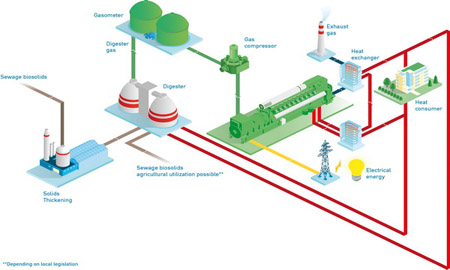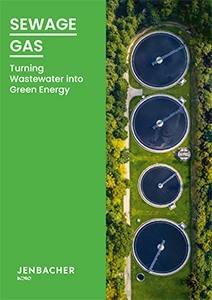
Wastewater professionals once accepted the high costs of operating wastewater treatment facilities as a consequence of meeting their discharge permit requirements. As the cost of energy rises and emphasis on renewable energy increases, local authorities and municipalities are seeking solutions that save money and meet renewable requirements. Energy’s Jenbacher gas engines provide a renewable energy solution through cogeneration / combined heat & power (CHP) that results in long-term savings for wastewater treatment plants
Conversion Steps from Sewage Gas to Renewable Power The process of biogas generation is divided into for steps:
1. Preparation of the input material including removal of physical contaminants
2. Digestion (fermentation), consisting of hydrolysis, acetogenesis, acidogenesis and methanogenesis
3. Conversion of the biogas to renewable electricity and useful heat through
cogeneration / CHP 4. Post-treatment of the digestion
Sewage is collected in municipal sewage systems and sent to the waste water treatment plant. From here it is prepared and sent to the sewage digesters. In the digestion tanks a series of biological processes are harnessed in order to produce biogas. Hydrolysis is the process where the organic material is solubilised into the digestion liquid. It then undergoes the intermediate steps of acidogenesis and acetogenesis which create the precursor molecules for methanogenesis. Methanogens feed off these precursors and produce methane as a cellular waste product. The biogas containing this biologically-derived methane is contained and captured in a gas storage tank which is typically located separately to the main digester. The gas storage tank acts as a buffer in order to balance fluctuations in the production of gas in the digesters. Where gas production levels are low or highly variable, dual fuel mixing can be used to supplement the sewage gas with natural gas from the mains distribution network.
Benefits of CHP for Sewage Treatment ● Generation of renewable energy from a waste material through cogeneration / CHP
● Reduction in carbon emissions especially compared to aerobic sewage treatment
● Economical onsite electrical power production & reduced transmission losses
● Production of a low-carbon fertilizer / soil improver
● Cost effective, proven technology
Waste Water Treatment Energy Costs Waste treatment processes include energy-intensive operations such as aeration and pumping. As a result, waste water treatment plants (WWTPs) require significant energy consumption. As electrical prices increase, plant operators are facing higher energy costs in order to meet discharge permit requirements. The second leading expense to WWTP owners is the cost of energy, behind only personnel. For plants, who employ anaerobic digestion for biosolids treatment, the process of combusting digester gas to produce electricity and heat through cogeneration/CHP may provide a solution to rising operational costs.
Features and Benefits ● LEANOX controls with turbo charger bypass help ensure the correct air-to-gas ratio to lessen exhaust gas emissions while maintaining stable engine operation.
● Electrical efficiency of up to 43% reduces the need to purchase energy from the public grid.
● A fully developed monitoring function, including remote monitoring, creates high levels of reliability.
● Maintenance intervals - 60,000 operating hours for major overhauls and 30,000 for cylinder heads - cut maintenance costs.
● Seamless dual fuel mixing evens out gas production fluctuations by supplementing natural gas as needed.
● High power engine density reduces space requirements and installation costs.
● The low-vibration engine has negligible impact on buildings.
If you would like to discuss your sewage gas project in more depth, please contact us.
-
 WWTP Gas - Brochure
WWTP Gas - Brochure

 Wastewater professionals once accepted the high costs of operating wastewater treatment facilities as a consequence of meeting their discharge permit requirements. As the cost of energy rises and emphasis on renewable energy increases, local authorities and municipalities are seeking solutions that save money and meet renewable requirements. Energy’s Jenbacher gas engines provide a renewable energy solution through cogeneration / combined heat & power (CHP) that results in long-term savings for wastewater treatment plants
Wastewater professionals once accepted the high costs of operating wastewater treatment facilities as a consequence of meeting their discharge permit requirements. As the cost of energy rises and emphasis on renewable energy increases, local authorities and municipalities are seeking solutions that save money and meet renewable requirements. Energy’s Jenbacher gas engines provide a renewable energy solution through cogeneration / combined heat & power (CHP) that results in long-term savings for wastewater treatment plants